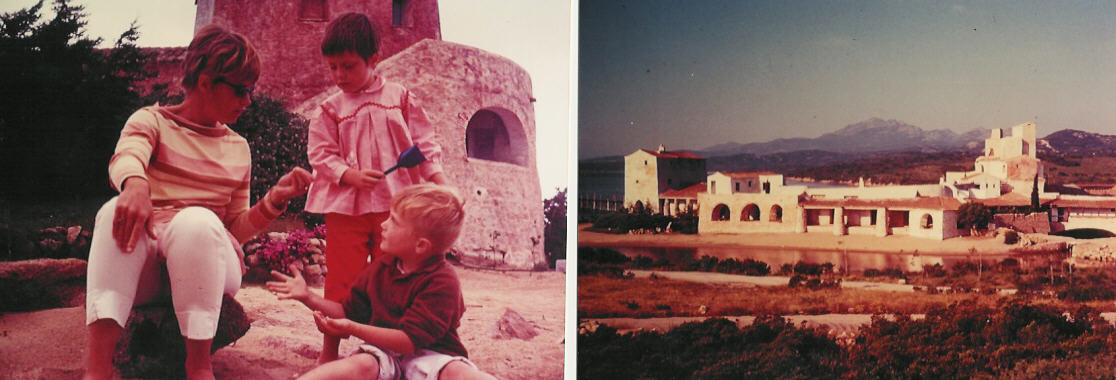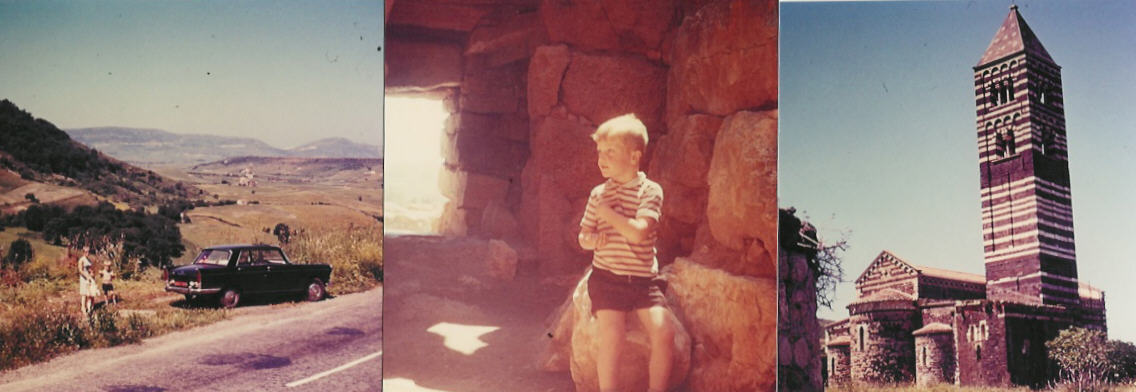
Sardinia (1966)
Italy’s Island Paradise In May of 1966, we left Marnie with our neighbors, the Poluks, and took a ferry to the island of Sardinia for the weekend to explore this beautiful Italian island in the Mediterranean Sea.The cruise on our ferry boat to Sardinia and back was as pleasant as the visit to the island itself. We had a second-class cabin for four and loaded the car up onto the deck for the thirteen hour, three hundred mile trip from Genoa to Porto Torres on the northern coast of Sardinia. The sea was calm and the weather was warm . . . so we all enjoyed getting back to the sea.
Festival. On the Monday before we left we learned that there was to be an island-wide festival on the day of our arrival (Annunciation Day) . . . so our timing couldn’t have been better. We arrived at eight o’clock in the morning and drove to Sassari just as the Cavalcade was starting. That was a real big thrill for Jill and Rob . . . and a photographer’s dream for me . . . the kids of things you see in travel posters but don’t believe. Each town was represented by a float. The Sardinian floats are a little different from the Rose Bowl floats in Pasadena and consist usually of an ox cart with some of the local lads and lasses in their colorful costumes in the back followed by the town beauties strolling by in their traditional dress . . . laced, colorful and elaborate and different town to town. After them came mounted young men charging down the street on their white horses . or intermittent dancing troupes with musicians with strange bagpipe-like instruments to accompany them.
 |
The events slowed down from noon to four . . . so we joined the crowd and passed that period in a restaurant sampling the local food. Val found lobster for the first time in Italy so was very happy. The afternoon finished with more dancing and a band concert in the square. We spent the night in a $5 but comfortable hotel in Algero, a nearby fishing village.
The next morning we drove up the coast to Capo Caccia to visit the Grotto di Nettuno . . .a beautiful cave which accesses from the sea. it is necessary to scale a cliff to get down to it. Before they constructed the stairs (600 of them), the only entrance was by sea. From there we drove over to the eastern coast. The drive across covered beautiful rolling hills . . . green, lush and for the most part uninhabited . . . except for an occasional shepherd tending his flock. We also drove through a region in which cork trees are harvested for their cork (bark), which is one of the island’s principal export along with wool and seafood products.
Cala da Volpe. In late afternoon, we happened upon a sprawl of Sardinian-style, adobe buildings nestled in the bend of one of Italy’s most breathtaking beaches which, on further investigation, turned out to be a hotel complex built and operated by the Ali Khan. It was a bit of a splurge but we couldn’t resist this charming hotel in the middle of nowhere along the Coast Smeralda, a fifty mile section of shoreline owned by the Khan. The hotel, called Cala de Volpe (Fox’s Den), was a charming blend of local architecture and luxury furnishings.
 |
Cala da Volpe, Emerald Coast
The Swiss hotel manager was very accommodating and complained that he had been wanting to change the style of the wine goblets . . . but that the Khan keeps putting him off in hopes that he (the Khan) could "find something a little more appropriate" in his next trip to London or India. We’re not yet so international that these conversations about "my boss . . . the Khan" . . . were not quite exciting to us.
Jill and Rob had dinner in the room (served on a cart with full china and crystal service and silver plate covers) and later, Val and I snuck out for a candlelight dinner off a French menu in the elegant dining room along with the other guests. On the final day we had to return to Sassari to confirm our return ferry reservations . . . and then we had the afternoon to ourselves so we found a stretch of beach, which we claimed for ourselves and swam, lay in the sun and did a little skin diving.
Nurage. One other exciting discovery on our drive along the back roads were several thousand nurage in various state of repair scattered across the island. The historic origin of the nurage is not known for sure . . .but they are thought to be the villages or defensive posts of some Mediterranean sea-faring groups, who visited the island at various times ranging from the 5th to the 19th century before Christ. The cone-shaped stone buildings, which range in height from five to ten feet, employ similar architectural techniques as the pyramids . . . and are unlike any orther ruins in the world. Again, like most everything else here, they are largely un-fenced, un-ticketed and un-publicized, which adds to the thrill of their discovery.
 |
Roadside Scene Inside a Nurage 11th Century Normal Church
As we found to be ]the case in most of our travels in Italy, it was these little, serendipitous discoveries . . mysterious ruins, unique hotels and local celebrations . . . that made each trip such a rich and wonderful experience.